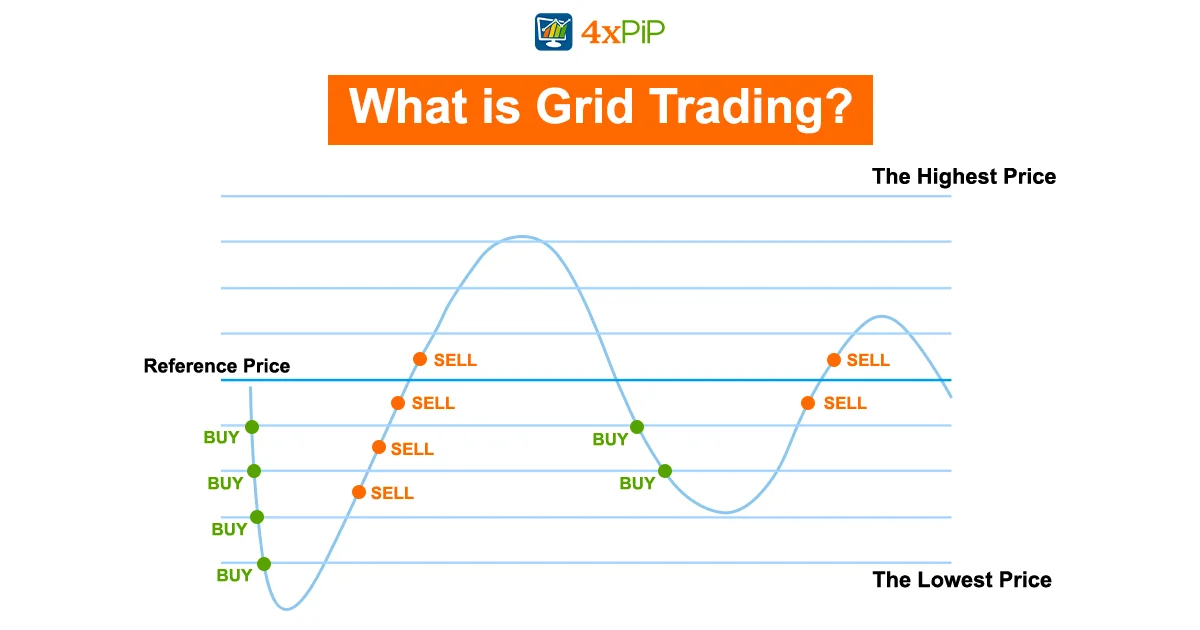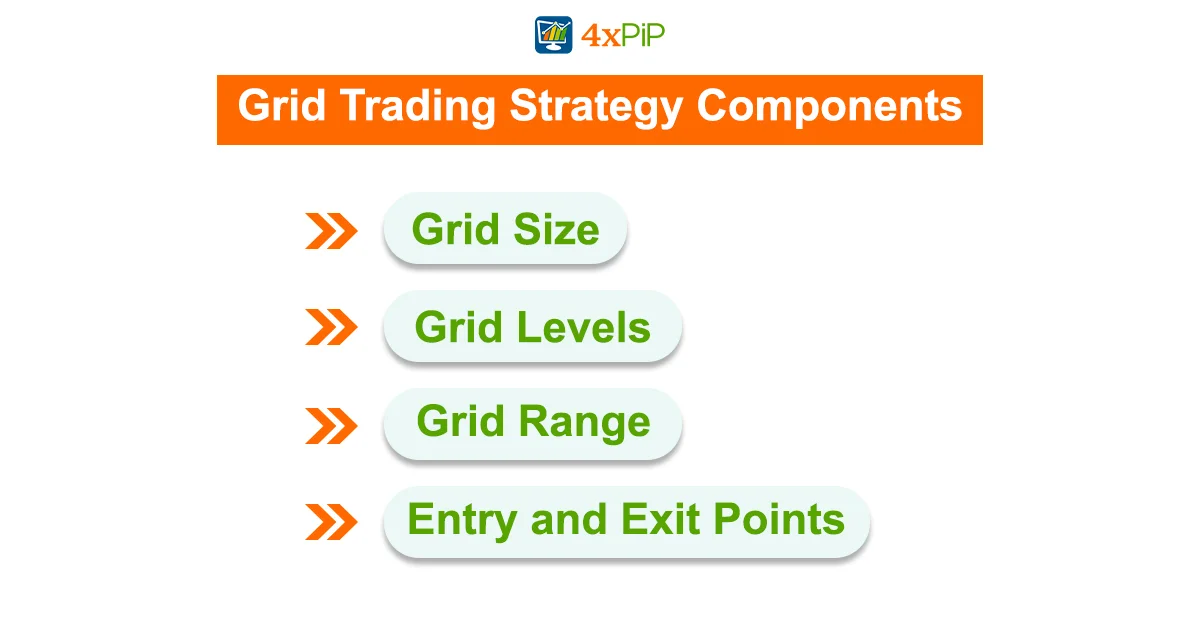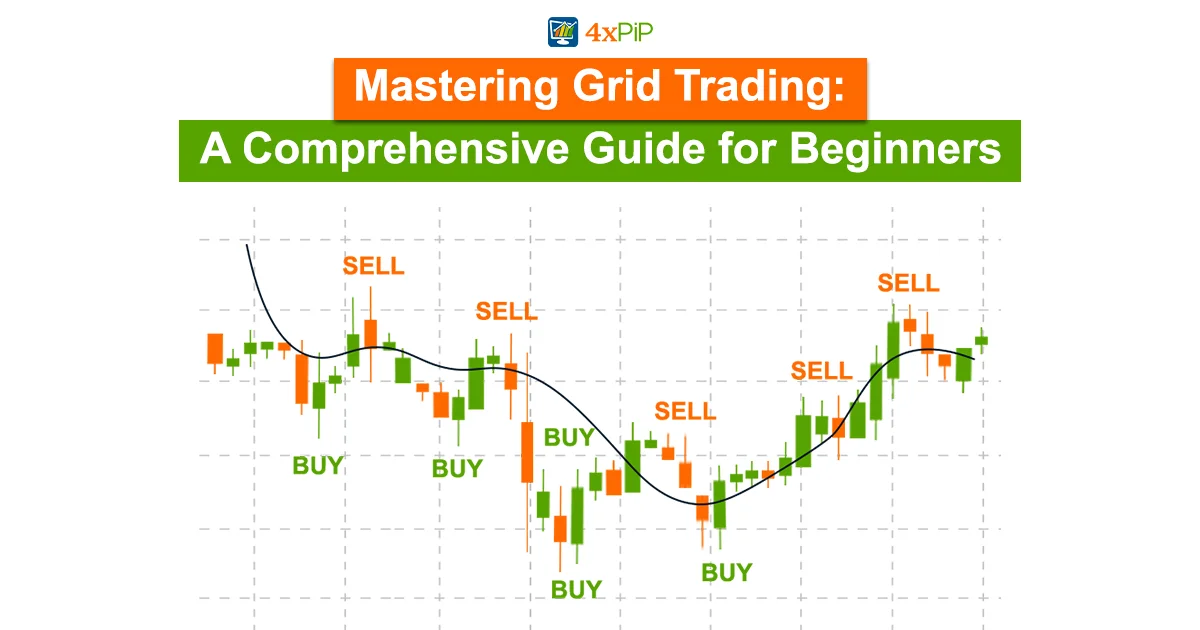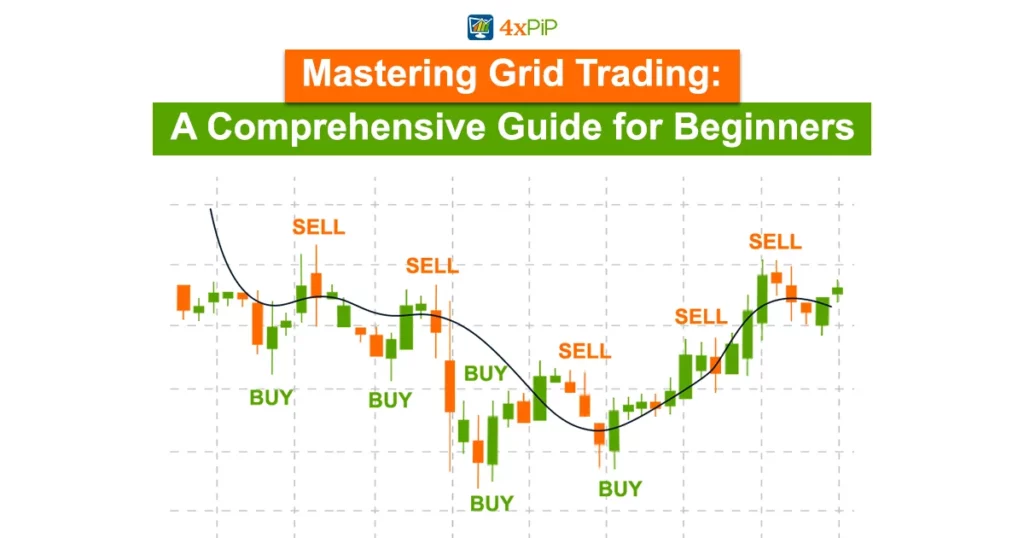In this comprehensive guide, 4xPip, your go-to source for trading insights, will unravel the complexity of Grid Trading. Whether you are a beginner or an experienced trader, understanding this systematic strategy is crucial for getting around the dynamic world of financial markets. For further assistance, contact 4xPip’s experts at [email protected].
What Is Grid Trading?

Grid trading, a systematic approach to getting Around financial markets, entails the strategic placement of buy and sell orders at predefined intervals within a structured grid. This systematic strategy aims to leverage short-term price fluctuations occurring within a specified range. The unique feature of grid trading lies in its ability to empower traders to accumulate profits without the necessity of predicting the direction of the overarching trend.
By executing trades at regular intervals, grid trading effectively captures the dynamic nature of volatile markets characterized by heightened fluctuations. The intentional placement of orders within this grid-like pattern allows traders to move around through the market’s unpredictable landscape, seizing opportunities as prices oscillate within the predetermined range. This adaptability positions grid trading as a valuable tool, especially when confronted with the challenges posed by volatile market conditions.
Grid Trading Strategy Components

Grid Size:
The grid size determines the distance between buy and sell orders, influencing profit potential and risk exposure. Smaller grids increase trade frequency and potential profits, while larger grids reduce both.
Grid Levels:
Grid levels are pre-defined price points for buy and sell orders. More levels increase profit opportunities but also increase in intensity grid management complexities.
Grid Range:
The grid range is the price span covered. Wider ranges capture significant fluctuations, while narrower ones offer fewer profit opportunities.
Entry and Exit Points:
Traders set entry and exit points based on technical and fundamental analysis, crucial for maximizing profits and minimizing risks.
Grid Trading Variations
Symmetrical Grid Trading:
Centers around a starting price with equal buy and sell distances, ideal for markets perceived as equally likely to move up or down.
Asymmetrical Grid Trading:
Involves different distances for buy and sell orders, useful when anticipating a specific market direction.
Multi-Grid Trading:
Utilizes multiple grids for different price ranges, capturing broader market movements but demanding careful management and higher capital.
Automated Grid Trading Systems:
Algorithms manage orders based on real-time market conditions, offering automated adjustments to grid size, levels, and range.
Grid Trading Benefits
Capturing Market Volatility:
By placing orders at various price levels, grid trading capitalizes on market volatility, enabling profit from price fluctuations in both directions.
Opportunity for Profit in Range-Bound Markets:
Effective in range-bound markets, grid trading capitalizes on price movements without predicting the trend direction, suitable for high volatility and fusion periods.
Simplicity and Adaptability:
Grid trading is adaptable to various market conditions, adjustable by changing grid size, levels, and range, applicable to different asset classes.
Limited Exposure to Single Trade Risks:
Multiple orders at various price levels reduce risk exposure, lessening the impact of adverse trades on the overall portfolio.
Grid Trading Limitations
Market Exposure During Strong Trends:
Grid trading can lead to increased market exposure and potential losses during strong trends. Proper risk management and strategy adaptation mitigate this risk.
High Transaction Costs:
Large numbers of trades within the grid can result in high transaction costs, including spreads and commissions. Traders must consider these costs when setting profit targets and risk thresholds.
Risk Management Challenges:
Managing risk with numerous open positions requires continuous monitoring and adjustments to prevent excessive losses, posing challenges for stop-loss and risk management tools.
Effectiveness in Sideways Markets:
While effective in range-bound markets, grid trading loses effectiveness in trending or sideways markets, limiting profit opportunities and increasing the risk of losses.
Steps to Implement a Grid Trading Strategy
Market Analysis and Selection:
Analyze market conditions, considering volatility, trading volume, and historical price movements. Select an appropriate asset.
Determination of Grid Size and Levels:
Define grid size and levels based on risk tolerance and profit targets, balancing potential profits with risks.
Setting up Entry and Exit Points:
Establish entry and exit points based on a combination of technical and fundamental analysis.
Monitoring and Adjusting the Grid:
Constantly monitor and adjust the grid based on market conditions, including grid size, levels, and range.
Risk Management Implementation:
Implement risk management with stop-loss and take-profit levels for each trade, managing overall portfolio risk.
Grid Trading Performance Metrics
Profitability Ratio:
Calculates total profit divided by total loss, indicating the strategy’s profitability.
Win-Loss Ratio:
Measures the number of winning trades compared to losing trades, determining strategy success.
Maximum Drawdown:
Indicates the largest loss from peak to trough in a trading account, a key measure of risk.
Risk-Adjusted Return:
Measures investment return relative to the risk taken, indicating the strategy’s effectiveness.
Grid Trading Examples
Forex Grid Trading:
Involves buying and selling currency pairs within a grid in the highly liquid and volatile forex market.
Cryptocurrency Grid Trading:
Trading digital currencies within a grid, profitable but with increased risk due to cryptocurrency market volatility.
Commodity Grid Trading:
Involves trading commodities like oil and gold within a grid, effective in the Periodic and volatile commodity markets.
Grid Trading Tips and Best Practices
Choosing Appropriate Market Conditions:
Implement grid trading in volatile, range-bound markets. Analyze market conditions carefully before putting in place of strategy.
Establishing Clear Risk Management Rules:
Define rules for setting stop-loss, take-profit levels, and managing overall portfolio risk.
Balancing Risk and Reward:
Balance potential rewards with associated risks by setting grid size, levels, and range carefully.
Evaluating Performance Regularly:
Regularly assess strategy performance using key metrics like profitability ratio, win-loss ratio, maximum drawdown, and risk-adjusted return.
Conclusion
Grid trading, while effective, requires careful market analysis, risk management, and continuous monitoring. Balancing benefits and limitations, this systematic strategy proves valuable in specific market conditions. For more insights and assistance, connect with 4xPip’s experts at [email protected].
FAQ’s
What is Grid Trading?
Grid trading is a systematic strategy placing buy and sell orders at regular intervals to capitalize on market fluctuations.
How does Grid Size affect trading?
Grid size determines trade frequency and potential profits; smaller grids increase trades, while larger grids reduce risk.
Furthermore, stop-losses also play a crucial role in assisting traders in calculating their position size, which refers to the number of shares or contracts they will buy or sell on a single trade. This strategic approach ensures that, by employing stop-losses, traders can effectively limit their losses and safeguard their profits.
Why is Entry and Exit crucial in Grid Trading?
Setting entry and exit points based on analysis maximizes profits and minimizes risk exposure.
What are the variations in Grid Trading?
Symmetrical, asymmetrical, multi-grid, and automated systems offer diverse approaches to grid trading.
Is Grid Trading effective in volatile markets?
Yes, grid trading is designed to capture profits in volatile, range-bound markets with high fluctuations.
How does Grid Trading adapt to different markets?
Adaptable to forex, cryptocurrencies, and commodities, grid trading adjusts to diverse market conditions.
What challenges does Grid Trading pose in trends?
Grid trading faces increased market exposure and potential losses during strong trends.
How does Risk Management work in Grid Trading?
Grid trading involves setting stop-loss and take-profit levels, requiring continuous monitoring for effective risk management.
What are the key performance metrics in Grid Trading?
Metrics include profitability ratio, win-loss ratio, maximum drawdown, and risk-adjusted return.
Is Grid Trading suitable for beginners?
Yes, with careful analysis, risk management, and understanding, grid trading can be suitable for beginners.












